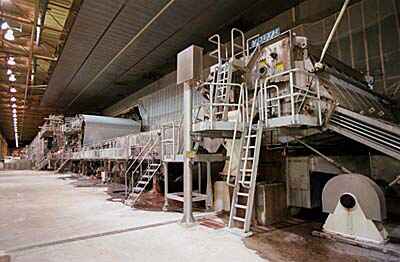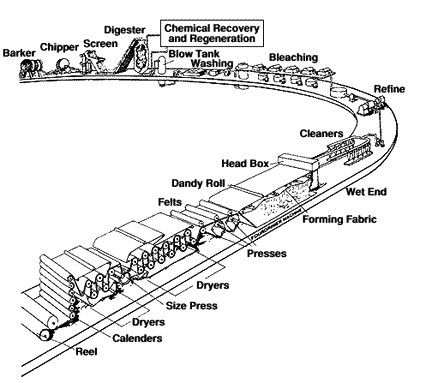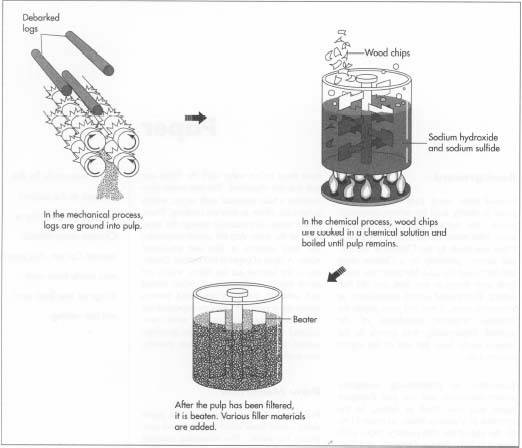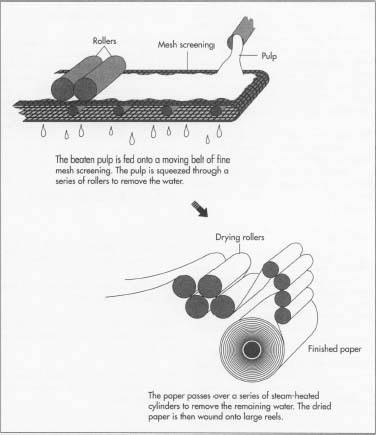

|
|

Fibers for
the
paper industry as reinforcement or as stabilizer in security or high
tech papers

PE and PP fibers for paper applications
Detailed information on paper
making
Paper production process:
- Wood or
other fibers are turned into pulp.
- The pulp meets the forming fabric of the flow box.
- At the wire part, the fibers are separated
from the water (filtration). Maximum drainage rates are obtained by foils and vacuum boxes.
- At the end of the wire the sheet leaves to go through the press sections.
- At the presses the sheet is consolidated to improve the fibre bonding and also to remove further water
from the sheet.
- The sheet is passed through steam heated drying cylinders. Evaporation takes place, aided by blowing warm dry air across the sheet.
The sheet moisture in this section reduces from 50-60% down to 5-6%.
- The surface of the paper can be made brighter and smoother by
applying a layer of coating either on the machine or as an post process.
- The paper is then polished by a treatment referred to as
super-calendaring.
- The paper is then reeled and stored until ready for slitting.
- The reels are transported to cutting factories where accurately cut into sheets for office use, labels, posters etc.

The Modern Paper Mill
The modern paper mill is a highly complex industrial facility.
To explore how a present-day paper mill operates, let's follow the path of an individual wood fiber from its arrival at the mill to its departure.
-
Delivery and Preparation
Most of the mill's raw material arrives in the form of logs. The logs are soaked in water and tumbled in slatted metal drums to remove the bark. The debarked logs are then fed into a chipper, a device with a rotating steel blade that cuts the wood into
small pieces about 1/8" thick and 1/2" square, stored and then carried by conveyor to the digester.
-
Pulping
Digesting is the process of removing lignin and other components of the wood from the cellulose fibers which will be used to make paper. Lignin is the "glue" which holds the wood together; it rapidly decomposes and discolors paper if it is left in the pulp.
The chips are fed into the top of a digester and mixed with the cooking chemicals, which are called "white liquor" at this point. As the chips and liquor move down through the digester, the lignin and other components are dissolved, and the cellulose fibers are released as pulp. At the bottom of the digester, the pulp is rinsed, and the spent chemicals (now known as "black liquor") are separated and recycled.
-
Bleaching and Refining
At this point, the "brown stock" pulp is free of lignin, but is too dark to use for most grades of paper. The next step is therefore to bleach the pulp by treating it with chlorine, chlorine dioxide, ozone, peroxide, or any of several other treatments.
The individual cellulose fibers are still fairly hollow and stiff, so they must be broken down somewhat to help them stick to one another in the paper web. This is accomplished by "beating" the pulp in the refiners, vessels with a series of rotating serrated metal disks. The pulp will be beaten for various lengths of time depending on its origin and the type of paper product that will be made from it. At the end of the process, the fibers will be flattened and frayed, ready to bond together in a sheet of paper.
-
Forming the Sheet
Once the pulp has been bleached and refined, it is rinsed and diluted with water, and fillers such as clay or talc may be added. This "furnish", containing 99% water or more, is pumped into the
head box of the paper machine. From the head box, the furnish is dispensed through a long, narrow "slice" onto the "wire", a moving continuous belt of wire or plastic mesh. As it travels down the wire, much of the water drains away or is pulled away by suction from underneath. The cellulose fibers, trapped on the wire as the water drains away, adhere to one another to form the paper web. From the wire, the newly formed sheet of paper is transferred onto a cloth belt (or "felt") in the press section, where rollers squeeze out much of the remaining water.
-
Coating, Drying, and
Calendaring
After leaving the press section, the sheet encounters the drying cylinders. These are large hollow metal cylinders, heated internally with steam, which dry the paper as it passes over them. The sheet will be wound up and down over many cylinders in the drying process. Between dryer sections, the paper may be coated with pigments, latex mixtures, or many other substances to give it a higher gloss or to impart some other desirable characteristic. After another round of drying, the paper sheet is passed through a series of polished, close-stacked metal rollers known as a
"calendar" where it is pressed smooth. Finally, the sheet is collected on a take-up roll and removed from the paper machine. From the
head box, it may have traveled half a mile or more in less than a minute.
-
Cutting and Packaging
In many cases, the new paper roll is simply rewound on a new core, inspected, and shipped directly to the customer. Other paper grades, however, may be further smoothed by passing them through a "super
calendar" where the sheet is polished by passing between steel and hard cotton rollers, or they may be embossed with a decorative pattern. The paper may also be cut into sheets at the mill, often by automatic equipment which accepts a roll of paper at one end and delivers packages of cut sheets at the other, already boxed and wrapped for shipping.
Papermaking today is one of the most capital-intensive industries, devoting large sums of money to the development and construction of newer and more efficient equipment and processes.

Paper in
our Life
- Printing, Media, and Entertainment
We read over billions of magazines, books and newspapers - all printed on paper. Our children play with paper dolls, paper masks, paper board games, and paper kites. Your ticket to a movie is made out of paper, and so are the containers and carry-out trays for your popcorn and drinks. Even the batteries in your TV remote control contain paper, and so does your television itself.
- At Work and School
Most of us expect to find paper in schools and businesses; our desks are usually covered with it. Thanks to computers, which were once expected to make ours a paperless society, we now generate even more paper than ever before. And our money, checks, stock certificates, deeds of ownership, birth certificates and marriage licenses, all the documents which govern our lives, are made out of paper.
- Packaging
How would you ship light bulbs, water glasses, or your new microwave oven without the corrugated containers that protect them? The largest category of paper products today is the one we take most for granted - paperboard. Corrugated board is used to ship 95% of all manufactured goods (even paper itself!) and is much lighter and more recyclable than the wooden crates of yesteryear.
- Construction
We use paper to build our homes. Sometimes it serves as a structural or decorative component, as in laminated kitchen counter tops, insulation, gypsum board, acoustical board, wallpaper, flooring, and shingles. Paper is the backing material for masking tape, sandpaper, and electrical cable wrap.
Synthetic Fibers in Paper
Main reason to use synthetic fiber such as HDPE or
LLDPE (polyethylene) or PP (polypropylene) is to provide the paper special
performance properties such as tearing strength, dimensional
stability in wet state, security features etc. End uses include papers for food
packaging, e.g. tea, coffee etc.
We are able to offer olefin fibers from Asota in the
following range:
- CoPP dtex 1,7 dtex (15µ) / 6,0 mm 140°C melting temperature
- HDPE dtex 2,8 dtex (19µ) / 6,0 mm
131°C melting temperature
- HDPE dtex 4,0 dtex (28µ) / 6,0 mm
131°C melting temperature
- LLDPE dtex 5,5 dtex (27µ) / 6,0 mm 115°C
melting temperature
- LLDPE dtex 7,0 dtex (31µ) / 6,0 mm 115°C
melting temperature
Supply is possible in pallet boxes or in bales.
The ideal length of the olefin fibers should be 6 mm. The
fibers disperse so quickly and easy, no refiner is needed. Olefin fibers can be mixed with pulp in a
ratio of up to 50%. When the right balance is achieved, the resulting sheet is durable, smooth and stable.
General Information
To understand the manufacturing of paper machine
clothing (PMC), it is first necessary to understand the papermaking process. Centuries ago, papermaking was an art, but evolving technology has turned the process into a highly technical science.
The Egyptians were the first to use papyrus for writing purposes in 4000 B.C. The thinly sliced stems of papyrus were beaten into hard, thin sheets and coated with a
glue-like material. The main difference between this process and today's papermaking process is that individual fibers were not separated.
In 105 A.D., the Chinese invented the papermaking process that is widely used today. Ts'ai Lun beat a water and mulberry tree mixture into a pulp. He then used a screen to separate the fibers and dried them in the sun, which resulted in the first sheet of paper made from wood.
The invention of the printing press in the mid-15th century increased the demand for paper. By the late 18th century, Nicholas Louis Robert invented the forerunner of today's modern paper machine. The Fourdrinier brothers bought his patent and made numerous improvements. The new machine was named after them and still carries their name today.
As improvements have been made to the paper machine, paper machine clothing has undergone many transformations to keep pace. Originally, press and dryer fabrics were made with wool and cotton, and forming fabrics were made with bronze wires. Increased machine width and speed led the paper machine clothing industry to change from using these raw materials to using synthetic fibers of polyester and nylon, which have much longer lives and produce a better quality of paper.
Pulp making
Paper is composed of cellulose fibers bonded together to form a sheet. The usual source of fibers is wood from trees. Wood consists of cellulose fibers held together by a
glue-like substance called lignin.
Pulping is the process of separating the wood into individual fibers. The paper end-product requirements determine both the type of wood used and the method by which it is pulped. For papers that require neither permanence nor high strength, such as newsprint, pulping is accomplished mechanically by holding logs against a water-lubricated grindstone. The grindstone tears the fibers apart into
ground wood pulp.
For papers that require strength, such as bag paper, or that require optical properties such as high whiteness, the pulp is manufactured chemically rather than mechanically. In the chemical pulping processes, the logs are first debarked and then cut into chips about one inch square. The chips are placed in a large steam-heated pressure cooker called a digester. Carefully controlled mixtures of alkalis or acids are used to dissolve the lignin without unduly harming the cellulose fibers. When the chemical cooking is completed, the pulp goes through a series of water-washing
processes to remove the dissolved lignin. At this point, the pulp is ready for use to make brown paper, such as grocery bags or corrugated boxes. However, if the pulp is intended for use in white papers, it
has to be bleached with chlorine or a series of other chemicals.
Prior to its use in papermaking, the pulp is normally put through a series of screens and centrifugal cleaners to remove dirt and debris that would be objectionable in the final sheet of paper.
Background information
Formed from wood pulp or plant fiber, paper is chiefly used for written
communication. The earliest paper was papyrus, made from reeds by the ancient
Egyptians. Paper was made by the Chinese in the second century, probably by a
Chinese court official named Cai Lun. His paper was made from such things as
tree bark and old fish netting. Recognized almost immediately as a valuable
secret, it was 500 years before the Japanese acquired knowledge of the method.
Papermaking was known in the Islamic world from the end of the eighth century A.D.
Knowledge of papermaking eventually moved westward, and the first European
paper mill was built at Jativa, in the province of Valencia, Spain, in about
1150. By the end of the 15th century, paper mills existed in Italy, France,
Germany, and England, and by the end of the 16th century, paper was being made
throughout Europe.
Paper, whether produced in the modern factory or by the most careful,
delicate hand methods, is made up of connected fibers. The fibers can come from
a number of sources including cloth rags, cellulose fibers from plants, and,
most notably, trees. The use of cloth in the process has always produced
high-quality paper. Today, a large proportion of cotton and linen fibers in the
mix create many excellent papers for special uses, from wedding invitation paper
stock to special paper for pen and ink drawings.
The method of making paper is essentially a simple one—mix up vegetable
fibers, and cook them in hot water until the fibers are soft but not dissolved.
The hot water also contains a base chemical such as lye, which softens the
fibers as they are cooking. Then, pass a screen-like material through the
mixture, let the water drip off and/or evaporate, and then squeeze or blot out
additional water. A layer of paper is left behind. Essential to the process are
the fibers, which are never totally destroyed, and, when mixed and softened,
form an interlaced pattern within the paper itself. Modern papermaking methods,
although significantly more complicated than the older ways, are developmental
improvements rather than entirely new methods of making paper.
Raw Materials
Probably half of the fiber used for paper today comes from wood that has been
purposely harvested. The remaining material comes from wood fiber from sawmills,
recycled newspaper, some vegetable matter, and recycled cloth. Coniferous
trees, such as spruce and fir, used to be preferred for papermaking because the
cellulose fibers in the pulp of these species are longer, therefore making for
stronger paper. These trees are called "softwood" by the paper
industry. Deciduous trees (leafy trees such as poplar and elm) are called
"hardwood." Because of increasing demand for paper, and improvements
in pulp processing technology, almost any species of tree can now be harvested
for paper.
Some plants other than trees are suitable for paper-making. In areas without
significant forests, bamboo has been used for paper pulp, as has straw and
sugarcane. Flax, hemp, and jute fibers are commonly used for textiles and rope making, but
they can also be used for paper. Some high-grade cigarette paper is made
from flax.

Cotton and linen rags are used in fine-grade papers such as letterhead and
resume paper, and for bank notes and security certificates. The rags are usually
cuttings and waste from textile and garment mills. The rags must be cut and
cleaned, boiled, and beaten before they can be used by the paper mill.
Other materials used in paper manufacture include bleaches and dyes, fillers
such as chalk, clay, or titanium oxide, and sizing such as rosin, gum, and
starch.
The Manufacturing
Process
Making pulp
- Several processes are commonly used to convert logs to wood pulp. In the
mechanical process, logs are first tumbled in drums to remove the bark. The
logs are then sent to grinders, which break the wood down into pulp by
pressing it between huge revolving slabs. The pulp is filtered to remove
foreign objects. In the chemical process, wood chips from de-barked logs are
cooked in a chemical solution. This is done in huge vats called digesters.
The chips are fed into the digester, and then boiled at high pressure in a
solution of
sodium hydroxide and sodium sulfide. The chips dissolve into pulp in the
solution. Next the pulp is sent through filters. Bleach may be added
at this stage, or colorings. The pulp is sent to the paper plant.

Beating
- The pulp is next put through a pounding and squeezing process called,
appropriately enough, beating. Inside a large tub, the pulp is subjected to
the effect of machine beaters. At this point, various filler materials can
be added such as chalks, clays, or chemicals such as titanium oxide. These
additives will influence the opacity and other qualities of the final
product. Sizing are also added at this point. Sizing affects the way the
paper will react with various inks. Without any sizing at all, a paper will
be too absorbent for most uses except as a desk blotter. A sizing such as
starch makes the paper resistant to water-based ink (inks actually sit on
top of a sheet of paper, rather than sinking in). A variety of sizings,
generally rosins and gums, is available depending on the eventual use of the
paper. Paper that will receive a printed design, such as gift wrapping,
requires a particular formula of sizing that will make the paper accept the
printing properly.
Pulp to paper
Finishing
- Finally, the dried paper is wound onto large reels, where it will be
further processed depending on its ultimate use. Paper is smoothed and
compacted further by passing through metal rollers called calendars. A
particular finish, whether soft and dull or hard and shiny, can be imparted
by the calendars.
The paper may be further finished by passing through a vat of sizing
material. It may also receive a coating, which is either brushed on or
rolled on. Coating adds chemicals or pigments to the paper's surface,
supplementing the sizings and fillers from earlier in the process. Fine clay
is often used as a coating. The paper may next be supercalendered, that is,
run through extremely smooth calendar rollers, for a final time. Then the
paper is cut to the desired size.
Environmental Concerns
The number of trees and other vegetation cut down in order to make paper is
enormous. Paper companies insist that they plant as many new trees as they cut
down. Environmentalists contend that the new growth trees, so much younger and
smaller than what was removed, cannot replace the value of older trees. Efforts
to recycle used paper (especially newspapers) have been effective in at least
partially mitigating the need for destruction of woodlands, and recycled paper
is now an important ingredient in many types of paper production.
The chemicals used in paper manufacture, including dyes, inks, bleach, and
sizing, can also be harmful to the environment when they are released into water
supplies and nearby land after use. The industry has, sometimes with government
prompting, cleared up a large amount of pollution, and federal requirements now
demand pollution free paper production. The cost of such clean-up efforts is
passed on to the consumer.
|


![]()




